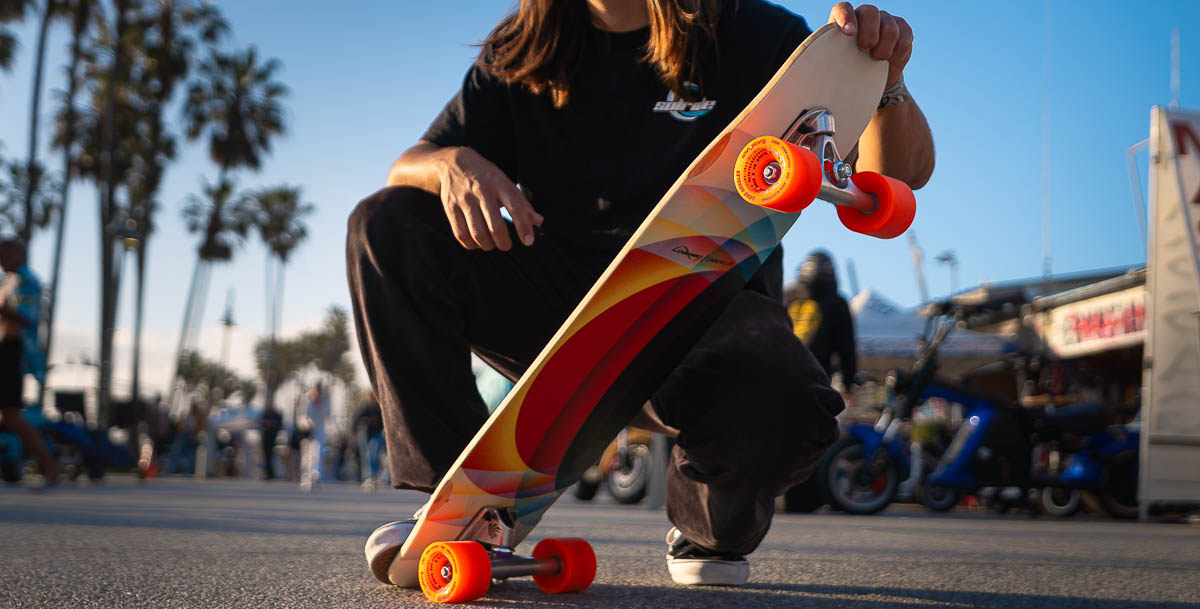5 min read • Jan 30, 2023

What's a longboard line? A guide to tricks, combos, and runs
.jpg?alt=media&token=0d5d2575-ec2e-4b86-b16f-f4263e747915)
Jeff Corsi - photo by Zenzel Photography
What is a longboarding line and why should you care? You may have seen a really cool video online of a longboard dancer combining tricks or moves together. Odds are, the video has at least one “line” in it.
In this post, we'll be exploring the different styles of longboarding and what makes a good line in each of them, with examples on how it's judged in competitions. So buckle up and get ready to add some serious knowledge to your longboarding arsenal!
What is a longboarding line?
A “line” in longboard dancing and freestyle is the collection of tricks you string together along a path. In order to be considered a line, the tricks or moves have to be completed continuously and consecutively, one after the other. Multiple pushes in the middle of a line would break it.
Although, a transition push like a lookback is ok as long as it doesn't break the flow and is performed seamlessly.
For example, a line might consist of a Frontside Pivot followed by a Cross Step followed by an Aero Grab.
In downhill skating, a line may be considered the path you take through a particular corner. “Race lines” are the most efficient path possible down the hill.
A line or a combo?
A “line” is different from a “combo” which is when 2 tricks are performed back-to-back without needing to adjust foot or body placement. Therefore, a combo is a smaller collection of tricks than a line.
A line can consist of multiple combos or single tricks strung together.
A line or a run?
A “line” is also different from a “run,” which is a term that encompasses an entire attempt, including combos, lines, slides, and pushes. A run is the longest collection of tricks.
In downhill skating, a run is the entire length of the hill from top to bottom. The term “run” can also be used as a way to refer to the road itself.
For example, in the So.. You Can Longboard Dance competition, your entire 1-min performance or submission video would be considered a run.
Or, to use music terminology:
- A trick is a note
- A combo is two notes tied together
- A line is a phrase
- A run is a song
.jpg)
A downhill run in the french alps - photo by Brandon DesJarlais
What makes a good line?
The qualities of a line that impresses folks and looks steezy depends on the style of longboarding that you’re skating. In general, a good longboard line is one where all tricks and combos flow together seamlessly.
Longboard dancing and freestyle competitions
If you enter into a longboard dancing competition, you will likely be judged according to ILDFF rules (International Longboard Dance and Freestyle Foundation) on how well you can execute a run. According to their rulebook, a well-executed run shows a good degree of difficulty, variety, and aesthetics.
Scoring scale
The judges will award points on a scale of 0 to 10 (in increments of .5) for 3 categories to grade overall presentation, based on the following scale.
- 0 - very poor
- 3 - poor
- 5 - average
- 7 - good
- 9 - very good
- 10 - outstanding
ILDFF judging categories
ILDFF-sanctioned longboard dancing competitions are judged by the following categories:
- Degree of difficulty of maneuvers and commitment
- Variety (dancing, freestyle, manuals, innovative moves)
- Aesthetic and personal expression (style of execution, creativity of tricks and routines)
- Consistency (ability to land tricks, sequences, or lines without bailing and while maintaining full control)
Flow factor
The ILDFF has also implemented a "Flow Factor". This is a judge's opportunity to appreciate remakable performances in terms of overall flow.
The flow factor acts as a multiplier to the total score with the following options:
- ×0.9 - Underperforming multiplier - athlete's performance does not look harmonious or well connected.
- x1.0 - Standard multiplier - applied as default value. The run is balanced and well connected.
- x1.1 - Outstanding multiplier - exceptionally good flow and transitions throughout the entire run.
Slopestyle freeride competitions
If you enter a freeride slopestyle competition, the judging will be based on combining lines of downhill tricks and slides in a single run. Standards for how these competitions are judged have not yet been established. Rules and criteria is expected to vary based on the particular host.
What are some examples of a line?
You can find them just about anywhere on the internet if you follow longboarders. We’ll also be highlighting lines in our upcoming “Line of the Week” series. Stay tuned!

for skaters, with loads of love.© Circa 2021 - Amp Skate LLC


